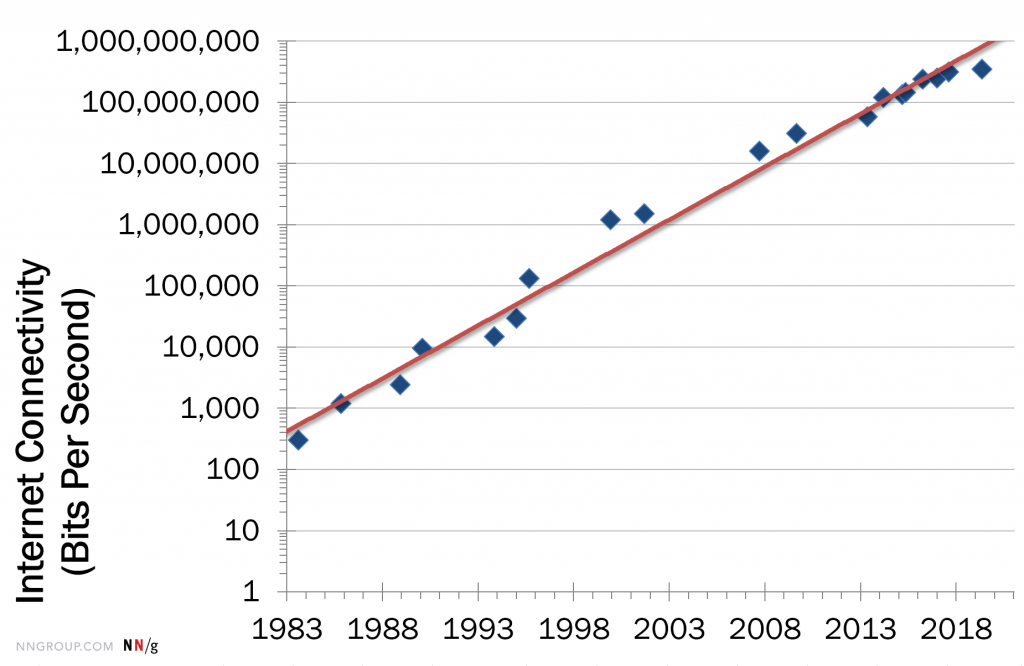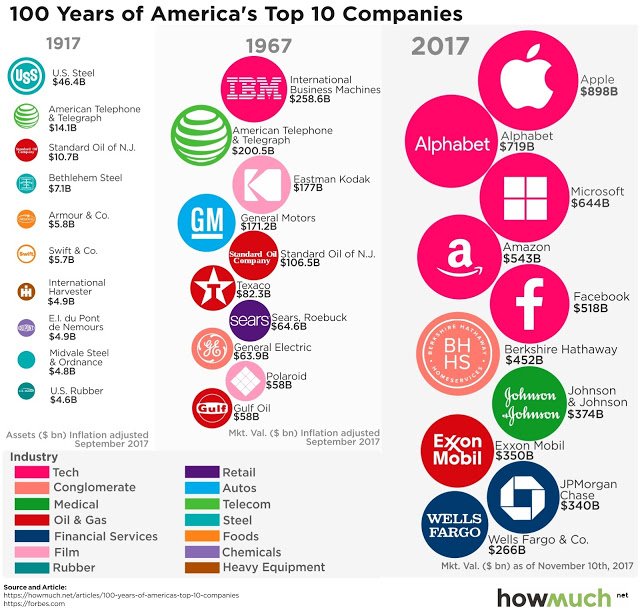The Origin of Digital Transformation: Moore, Metcalfe, and Gilder

Two years ago, in What is Digital Transformation?, I provided my definition; in this post, I will discuss the origins of Digital Transformation.
The phenomenon of Digital Transformation would be unthinkable without the growth of processing power, connectivity capabilities, and cloud processing.
Therefore, despite being a trendy and modern term, the reality is that the origin of Digital Transformation lies in two laws published about 50 years ago and a third one over 20 years ago.
The first two are:
- Moore’s Law, which governs the evolution of processors
- Metcalfe’s Law, which determines the value of networks
As the saying goes, there are three of a kind, the Bandwidth Law by Gilder (growth of communications) is the perfect complement to the previous two.
These three laws have determined fundamental aspects of the current development of technology, economy, and society, in addition to explaining the origins of Digital Transformation.

Cover of the Electronics issue in which Moore’s Law was published (Wikipedia)
In this post, I will explain why the exponential growth of computing capacity (Moore’s Law) and the value of networks according to the number of nodes (Metcalfe’s Law), enhanced by the increase in the volume of data transmitted (Gilder), are key to the origin of Digital Transformation.
I will also explain their limitations and the consequences of those limitations.
To begin, a definition.
Digital Transformation
As I mentioned in What is Digital Transformation?, it is:
A radical change in business facilitated by the combinatorial effect of technologies that merges the physical and digital worlds to meet customer expectations.
Its goal is to achieve scalability (of products/services to more customers/users), reach (generating greater variety of products/services), and speed (in growth in scalability, reach, or both) necessary for the success of a business in the digital world.
With the term clarified, let’s move on to the three laws that are the origin of Digital Transformation.
Let’s start with Moore: the most well-known and controversial.
What is Moore’s Law?
In 1965, Gordon Moore published in Electronics magazine:
“The complexity for minimum component costs has increased at a rate of roughly a factor of two per year. Certainly over the short term this rate can be expected to continue, if not to increase. Over the longer term, the rate of increase is a bit more uncertain, although there is no reason to believe it will not remain nearly constant for at least 10 years.”
Gordon Earle Moore, Electronics, April 1965
This statement is the origin of the Moore’s Law, which states that the complexity (measured as the number of transistors) of integrated circuits doubles every year while prices and manufacturing costs decrease.
In the following video, Moore himself explains it on the 50th anniversary of his publication.
Gordon Moore 50 years after publishing his Law
Moore’s Law is an empirical law. Its prediction is based on Moore’s privileged and detailed observations from his position at Fairchild Semiconductor and Intel.
In 1975, Moore modified his law upon observing a slowdown in evolution, indicating that the number of transistors in a processor would go from doubling every 12 months to every 24 months.
Moore’s Law only considers the number of transistors, but in the performance of a processor, it is necessary to add other key factors today, such as the speed of transistors or their energy consumption.
This last point also leads to the interpretation of it as doubling capacity every 18 months (including the other variables).
Limitations of Moore’s Law
Despite its compliance decade after decade, Moore’s Law has always been criticized for being considered an observation and not a law or standard that can be imposed or is guaranteed to be fulfilled.
It is also criticized that for its compliance as an engine of economic growth, in times of uncertainty, it has required significant public and private investments in R&D, calling into question the promised “cost reduction.”
These criticisms are compounded by observations that every two years we are closer to the physical limits of processors and that, therefore, technology is reaching a point of stagnation. Leading analysts, including Moore himself, predict that stagnation will occur in 2025.
In 2016, MIT Technology Review predicted this stagnation would occur in 2021. In February of this year, that same publication released an article titled “We’re not prepared for the end of Moore’s Law” stating that we are reaching the limit of Moore’s Law.
The limit is determined by physical aspects but also by the increasing costs of maintaining the growth rate. It is becoming more expensive to increase the number of transistors in a processor.
Moreover, the creation of specialized processors (especially GPUs adapted for Artificial Intelligence) reduces the pressure on investment in general-purpose processors (CPUs).
The result is that we are approaching that exhaustion, and, more critically, despite advances in quantum computing (see “10 Emerging Technologies of 2020 that Will Transform the World”), we are far from having an immediate alternative.
The following video, created by datagrapha, visualizes the degree of compliance from 1965 to 2019 of Moore’s Law (highly recommended despite the background loop).
Visualization of Moore’s Law from 1965 to 2019
What is Metcalfe’s Law?
This law, published in 1976 by Robert Metcalfe, predicts that the value of a telecommunications network increases proportionally to the square of the number of users in the system (the square of the nodes).
Robert Metcalfe, co-inventor of Ethernet and founder of 3com, formulated his law in relation to Ethernet, considering that the value of the nodes was constant.
This law explains the network effect, whereby the increase in participants or users of a business exponentially increases its value.
The network effect generates a crucial competitive advantage for the success of a business, causing effects such as the growth of platform business models (see “What is Your Digital Business Model?”) or the “one-takes-all” described by Peter Thiel in “From 0 to 1.”
Limitations of Metcalfe’s Law
The main criticisms of Metcalfe’s Law come from the quantification of the value of the network. Designed for Ethernet and illustrated with the example of connected printers, Metcalfe proposes an environment where the value of all nodes is the same.
There have been various adjustments made after the publication of Metcalfe’s law, including those made by the creator himself, which employ his logarithm or the elimination of one of the nodes in the calculation.
Despite everything, different experiments have simulated the calculation of the value of companies like Facebook or Tencent and cryptocurrencies like Bitcoin with acceptable results.
In 2013, Metcalfe himself demonstrated with data from the last 10 years of Facebook that the value of the network aligned with its value calculated according to the original Metcalfe’s Law (the square of the number of users).
No Two Without Three: Bandwidth Laws
This law is the most modern of the three and has its specific weight in the origin of Digital Transformation.
Published by George Gilder in 1994 in his book “Life After Television,” it is known as Gilder’s Law or the “Bandwidth Law.”
According to this law, bandwidth grows at least three times faster than computing capacity.
A later version of this law is the “Nielsen’s Law of Internet bandwidth,” which states that user bandwidth grows by 50% per year. According to studies, this progression has been followed between 1983 and 2019, and this new law has been upheld.

Evolution of Bandwidth 1983-2019 – NNGroup
The Origin of Digital Transformation: Moore, Metcalfe, and Gilder Combined
If we recall the beginning, in the definition of Digital Transformation, I speak of the “combinatorial effect of technologies,” and it is no coincidence. Its impact comes from the combination of technologies. The same applies to these three advancements.
We have seen decades of almost exponential growth in processing capacity at increasingly lower costs (Moore’s Law), growth in the value of networks as their size increases (Metcalfe), and expansion of communications (Gilder).
This has allowed, among other advancements, the cloud computing we know today.
Digital businesses rely on connectivity, data, and computing power. Nothing new; all of this has been available for years. The difference is that now they are extremely accessible to anyone.
Currently, a startup with 5 employees can access the same technology as a company with 10,000 employees. The result is that the former can create a business model that competes with the latter and even displace or eliminate it from the market.
Metcalfe, Moore, and Gilder explain the why of this global accessibility.
Despite its limitations, Moore’s Law has allowed us to incorporate processors into our cars, televisions, washing machines, and toothbrushes. Thanks to Gilder’s Law, we have connected them in the IoT (Internet of Things) as we know it today.
I remember the VAX servers from my college days, and I am continually amazed that I now carry a processing capacity greater than that in my pocket.
Moore has also enabled the evolution of current Artificial Intelligence, allowing calculations that once took days to be performed in seconds. Algorithms and AI are also in our pockets.
Simple and less optimized programming languages (like Python) have accelerated the development of technological advancements such as Data Science and Artificial Intelligence.
Metcalfe helps us understand the growth of the Internet, the impact of social networks, the platform economy, and, related to the above, the enormous investment and evolution of cloud services.
Gilder has ensured an increase in bandwidth, achieving the state of hyper-connectivity in which we currently live. We not only have a VAX in our pocket, but we also have it connected to a volume of data that was unthinkable in another era.
Without Metcalfe and Gilder, platform businesses and the development of the cloud could not have existed.
Computing, connectivity, and cloud are the origins of what we call Digital Transformation. In the digital economy, new business models are leveraging these capabilities.
This is reflected in the evolution of company valuations. Below is a chart of this evolution created by Howmuch using data from Forbes.

Evolution of Top 10 in the USA
Impact of the End of Moore’s Law
Moore’s Law is largely responsible for economic growth, technological advancements experienced, and the origin of Digital Transformation.
In the past, when the degree of advancement seemed to slow down, the U.S. government invested alongside companies to accelerate the development of processors. The situation has changed, and that level of commitment no longer exists.
At the point we are at, the cost of R&D for each new advancement is increasingly higher. It is not only about the physical limit but also the costs associated with surpassing those limits.
In the short term, researchers are trying to incorporate vertical layers of transistors to be able to surpass the limit, but a solution at a reasonable cost does not seem to exist.
On the other hand, despite advances in Quantum Computing mentioned in the previous post “10 Emerging Technologies of 2020 that Will Transform the World,” we are far from it being an alternative.
The impact of this slowdown and the lack of a short-term alternative may affect the advancement of many technologies.
In Artificial Intelligence and Blockchain, the short-term alternative involves using GPUs (graphics processing units) typically employed in video games. However, in the medium term, it does not seem to be an alternative that can sustain the pace of evolution of these technologies.
The scarcity of computing power may require a return to languages that optimize its use. For example, C is much more efficient than Python, but the learning curve is also steeper.
If, as Marc Andreessen said, “software is eating the world,” it may soon become a heavier digestion. Perhaps we need to change the paradigm by returning to more complex but also more optimized languages.
Venturing into other areas, advancements in Genomics, medicine, and other sciences may also be affected by this potential technological stagnation.
If we currently consider DNA analysis as a consumer good (costing between €100 and €200), it is due to the increase in processing capacity in recent years that has allowed for accelerated research and analysis of studies. To see similar scientific advancements in the coming years, we need to rely on equivalent growth in processing capacity.

Installation of Moore’s Law
For all these reasons, the foreseeable slowdown in Moore’s Law may also mean a slowdown in the most promising technological advancements and, therefore, in the economy that relies on them.
Conclusions on the Origin of Digital Transformation
The origin of Digital Transformation lies in the combination of the almost exponential growth of processor capacity combined with the use of cloud computing and the growth of available bandwidth.
Moore’s Law (evolution of processors), Metcalfe’s Law (value of networks), and Gilder’s Law (connectivity) are fundamental to the technological evolution of recent decades, the economy, and, of course, the origin of Digital Transformation.
REFERENCES
Below are the references used in this post:
- What is Digital Transformation? – digital-rocks
- 10 Emerging Technologies of 2020 that Will Transform the World – digital-rocks
- What is Your Digital Business Model? – digital-rocks
- Do The Evolution – digital-rocks
- The Digital Matrix – Venkat Venkatraman
- We’re not prepared for the end of Moore’s Law – MIT Tech Review
- datagrapha
- Moore’s Law – Wikipedia
- Metcalfe’s Law – Wikipedia
- A Century of America’s Top 10 Companies, in One Chart – Howmuch
Marilyn Manson
I apologize for the obvious association, but in a post with two Ms in the title (Metcalfe and Moore), I couldn’t resist.
In the late ’90s, I remember listening to Marilyn Manson with friends. That icon of ’90s industrial rock, who despite the years refuses to stop being controversial and cursed.
I leave you with “Sweet Dreams,” originally by Eurythmics, the hit that brought him fame.
Related posts

From COBOL to Agentic AI: Transforming the Software Lifecycle
Evolution of the software lifecycle applying AI and Agentic AI

Digital Transformation: Beyond Technology
In Digital Transformation, purpose and culture are more important than technology itself.

BIG TECH CAPITALISM by Evgeny Morozov
'Big Tech Capitalism' shares many of the issues I describe in 'The End of Inertia' but does not approach them in the same way, as its author starts from an e...
All opinions expressed on this blog are personal and do not represent those of any company or organization with which I collaborate.
